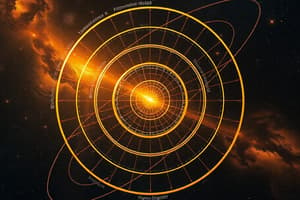Podcast
Questions and Answers
Which model places the Sun at the center of the solar system?
Which model places the Sun at the center of the solar system?
- Planetary model
- Telescope model
- Heliocentric model (correct)
- Geocentric model
Nicolaus Copernicus wrote De revolutionibus orbium coelestium after his death.
Nicolaus Copernicus wrote De revolutionibus orbium coelestium after his death.
False (B)
What significant change did Copernicus's heliocentric model bring to the understanding of the solar system?
What significant change did Copernicus's heliocentric model bring to the understanding of the solar system?
It placed the Sun at the center instead of the Earth.
Nicolaus Copernicus was born in __________, Poland.
Nicolaus Copernicus was born in __________, Poland.
What aspect of planetary motion did Copernicus's model propose?
What aspect of planetary motion did Copernicus's model propose?
Copernicus faced significant __________ to his heliocentric theory.
Copernicus faced significant __________ to his heliocentric theory.
Match the following associated terms with Copernicus's contributions:
Match the following associated terms with Copernicus's contributions:
What was emphasized in Copernicus's De revolutionibus orbium coelestium?
What was emphasized in Copernicus's De revolutionibus orbium coelestium?
Flashcards
Heliocentric Model
Heliocentric Model
The theory where the Sun remains stationary at the center of the solar system, while the Earth and other planets revolve around it.
Geocentric Model
Geocentric Model
A model of the universe that places the Earth at the center, with all other celestial bodies revolving around it.
De revolutionibus orbium coelestium
De revolutionibus orbium coelestium
Nicolaus Copernicus's groundbreaking book detailing his heliocentric model of the solar system, published in 1543, the year of his death.
Canon of Frauenburg Cathedral
Canon of Frauenburg Cathedral
Signup and view all the flashcards
Geocentric Theory
Geocentric Theory
Signup and view all the flashcards
Copernican Revolution
Copernican Revolution
Signup and view all the flashcards
Circular Orbits
Circular Orbits
Signup and view all the flashcards
Earth's Rotation
Earth's Rotation
Signup and view all the flashcards
Study Notes
Early Life and Education
- Born Nicolaus Copernicus on February 19, 1473, in Toruń, Poland.
- Father was a merchant.
- Received a good education, studying at the University of Kraków, then later in Bologna, Padua, and Ferrara.
- Studied canon law, medicine, and astronomy.
Canon of Frauenburg Cathedral
- Appointed to a canonry in the cathedral chapter of Frauenburg.
- This gave him financial security and free time for scientific work, including astronomy.
Heliocentric Model
- Developed the heliocentric theory—a model of the solar system in which the Sun, instead of the Earth, is at the centre.
- This challenged the prevailing geocentric view, which placed the Earth at the center.
- Main points of his model:
- The Sun is stationary at the centre of the Solar system.
- The Earth is a planet which, like other planets, orbits the Sun.
- Earth rotates on its axis, causing day and night.
- The perceived movement of celestial bodies was due to the Earth's motion, not their actual movement.
- His model retained some features of earlier models, such as circular orbits.
- Faced significant resistance to his theory.
De revolutionibus orbium coelestium
- Wrote De revolutionibus orbium coelestium ("On the Revolutions of the Heavenly Spheres"), a detailed exposition of his heliocentric model.
- Published the book in 1543, the year of his death.
- The book meticulously presented mathematical arguments and astronomical observations supporting his theory.
- Detailed the mathematical aspects of his model.
- Utilized mathematical tools and complex calculations to support his model.
Impact and Legacy
- His ideas marked a turning point in the history of astronomy.
- His theory revolutionized the understanding of the cosmos.
- The heliocentric model is the foundation of modern astronomy.
- His work inspired further scientific research, ultimately leading to the acceptance of his model.
- His model was not immediately accepted but laid the groundwork for future discoveries.
- His work was a significant contribution to scientific progress.
- It took centuries for his theories to gain widespread acceptance, facing resistance from the Church and established thinkers.
- Though not entirely accurate (the orbits were elliptical, not circular), it marked a paradigm shift.
- His mathematical descriptions and predictions significantly improved accuracy compared to previous models.
- His ideas stimulated debate and further investigation in cosmology and astronomy.
Death
- Died on May 24, 1543, in Frombork, Poland.
- The day he died, he received his first printed copy of De revolutionibus orbium coelestium.
Studying That Suits You
Use AI to generate personalized quizzes and flashcards to suit your learning preferences.



